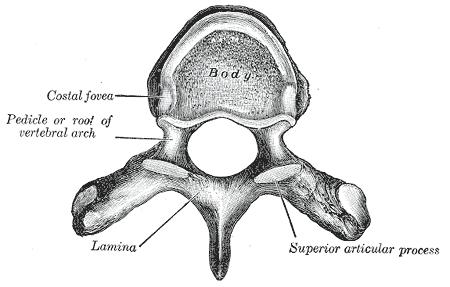- Laminectomy
Interventions infobox
Name = PAGENAME

Caption = Upper view of a human vertebra, showing the lamina
ICD10 =
ICD9 = 03.09
MeshID = D007796
OtherCodes =Laminectomy is a spine operation to remove the portion of the vertebral bone called the lamina. There are many variations of laminectomy, in the most minimal form small skin incisions are made, back muscles are pushed aside rather than cut, and the parts of the vertebra adjacent to the lamina are left intact. The traditional form of laminectomy (conventional laminectomy)excises much more than just the lamina, the entire posterior backbone is removed, along with overlying ligaments and muscles. The usual recovery period is very different depending on which type of laminectomy has been performed: days in the minimal procedure, and weeks to months with conventional open surgery.
As pictured,the lamina is a posterior arch of the vertebral bone laying between the spinous process, which juts out in the midline, and the more lateral of each vertebra. The pair of lamina, along with the spinous process, make up the posterior wall of the bony
spinal canal . Although the literal meaning of laminectomy is excision of the lamina, the operation called conventional laminectomy, which is a standard spine procedure inneurosurgery andorthopedics , removes the lamina, spinous process and overlying connective tissues and ligaments,cutting through the muscles that overlie these structures. Minimal surgery laminectomy is a tissue preserving surgery that leaves the muscles intact, spares the spinal process and takes only one or both lamina. Laminotomy is removal of a mid-portion of one lamina and may be done either with a conventional open technique, or in a minimal fashion with the use of tubular retractors and endoscopes.A lamina is rarely, if ever, removed because it itself is diseased. Instead, removal is done to: (1) break the continuity of the rigid ring of the spinal canal to allow the soft tissues within the canal to expand (decompression), or (2) as one step in changing the contour of the vertebral column, or (3) in order to allow the surgeon access to deeper tissues inside the spinal canal. Laminectomy is also the name of a spinal operation that conventionally includes the removal of one or both lamina as well as other posterior supporting structures of the vertebral column, including ligaments and additional bone.
Conventional open laminectomy often involves excision of the
posterior spinal ligament , and some or all of the spinous process, and facet joint. Removal of these structures, in the open technique, requires cutting the many muscles of the back which attach to them. Laminectomy performed as aminimal spinal surgery procedure, however, allows the bellies of muscles to be pushed aside instead of transected, and generally involves less bone removal than the open procedure.The success rate of laminectomy depends on the specific reason for the operation, as well as proper patient selection and technical ability of the surgeon. Indications for laminectomy include (1) treatment of severe
spinal stenosis by relieving pressure on thespinal cord or nerve roots, (2) access to a tumor or other mass lying in or around the spinal cord, or (3) a step in tailoring the contour of the vertebral column to correct a spinal deformity such askyphosis . The actual bone removal may be carried out with a variety of surgical tools, including drills, rongeurs, and laser.The recovery period after laminectomy depends on the specific operative technique; minimally invasive procedures having a significantly shorter recovery period than open surgery. Removal of substantial amounts of bone and tissue may require additional procedures to stabilize the spine, such as fusion procedures, and
spinal fusion generally requires a much longer recovery period than simple laminectomy.Most commonly, laminectomy is performed to treat spinal stenosis.
Laminectomy for Spinal Stenosis
Spinal stenosis is the single most common diagnosis leading to "any" type of spine surgery, and laminectomy is a basic part of its surgical treatment. Thelamina of thevertebra is removed or trimmed to widen thespinal canal and create more space for thespinal nerve s andthecal sac . Surgical treatment that includes laminectomy is the most effective remedy for severe spinal stenosis, however most cases of spinal stenosis are not severe and do not require surgery. When the disabling symptoms of spinal stenosis are primarilyneurogenic claudication , and the laminectomy is done without spinal fusion, there is generally a very rapid recovery with excellent long term relief. However, if the spinal column is unstable, and fusion is required, there is a recovery period of months to more than a year, and relief of symptoms is less likely.The first laminectomy was performed in
1887 by Dr. Victor Alexander Haden Horsley, a professor of surgery at theUniversity College London . He was lauded for his breakthrough procedure.A common type of laminectomy is performed to permit the removal or reshaping of a spinal disc as part of a lumbar
discectomy . This is a treatment for a herniated disc, bulging or degenerated disc."'Results of the surgical treatment
In most known cases of lumbar and thoracic laminectomies patients tend to recur pain/spinal stenosis for a period of 1 / 1.5 years and tend to recover very slowly.According to a W.H.O. census in 2001, most patients who had undergone lumbar laminectomy recovered normal functioning a year after their operation.
ee also
*
Artificial facet replacement External links
* [http://www.ascent-oxford.kramesonline.com/HealthSheets/3,S,82372 Laminectomy - Information for Patients]
* [http://www.betterhealth.vic.gov.au/BHCV2/bhcarticles.nsf/pages/Laminectomy?open Laminectomy - Better Health Channel]
* [http://www.wehealny.org/services/rvt_spinesurgery/index.html] Explanation and illustration of minimal spine surgery laminectomy
Wikimedia Foundation. 2010.
